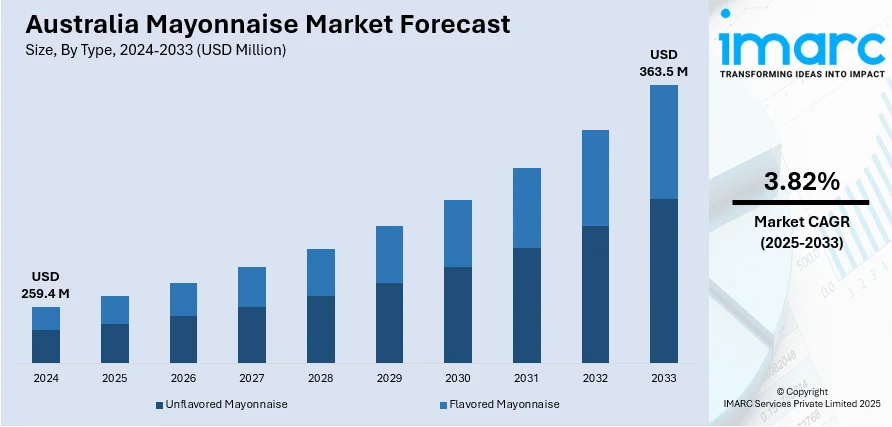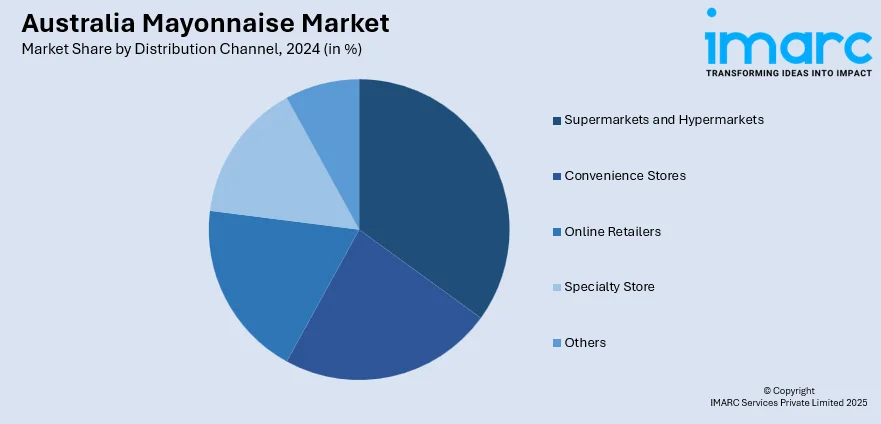
Australia Mayonnaise Market Size, Share, Trends and Forecast by Type, Distribution Channel, End Use, and Region, 2025-2033
Australia Mayonnaise Market Overview:
The Australia mayonnaise market size reached USD 259.4 Million in 2024. Looking forward, IMARC Group expects the market to reach USD 363.5 Million by 2033, exhibiting a growth rate (CAGR) of 3.82% during 2025-2033. The market is expanding steadily, driven by changing dietary habits, growing demand for convenience foods, and increased consumer preference for flavored and organic mayonnaise options across retail and food service channels.
|
Report Attribute
|
Key Statistics
|
|---|---|
|
Base Year
|
2024
|
|
Forecast Years
|
2025-2033
|
|
Historical Years
|
2019-2024
|
| Market Size in 2024 | USD 259.4 Million |
| Market Forecast in 2033 | USD 363.5 Million |
| Market Growth Rate 2025-2033 | 3.82% |
Australia Mayonnaise Market Trends:
Rise in Flavored and Organic Variants
The consumer interest in healthier ingredients and distinctive flavors has raised the demand for flavored and organic mayonnaise. Increasing health consciousness is prompting consumers to move towards products with cleaner labels, natural ingredients, and plant-based content. The change is also aided by increasing vegan and flexitarian populations who proactively look for egg-free or dairy-free mayonnaise. The food companies are reacting by launching new forms, such as avocado-based, olive oil-based, and low-fat versions. These innovations seek to catch the imagination of young and health-conscious consumers. Packaged mayonnaise with herbs, spices, or ethnic flavors is also gaining traction in urban supermarkets and online platforms. This trend is particularly evident among millennials and Gen Z shoppers who are looking for more experimental tastes in everyday food items. Retailers are adjusting shelf space to include niche and premium mayonnaise brands, making them more accessible. This increase in availability across different formats is supporting higher sales volumes. Meanwhile, traditional brands are also reformulating existing lines to maintain relevance in a changing market. Product launches in 2023 focused on regional flavors and allergen-free ingredients, reflecting how deeply brands are now investing in diversification and innovation within this segment.

Growth Through Foodservice Expansion
The mayonnaise market in Australia is also seeing momentum from rising food service demand. Quick-service restaurants (QSRs), cafés, and casual dining outlets continue to use mayonnaise-based dressings and sauces in sandwiches, burgers, and salads. As these establishments prioritize both consistency and taste, bulk-sized and tailored mayonnaise solutions are in demand. The food service sector’s push for efficiency has led to partnerships with suppliers offering ready-to-use and custom flavor blends. Additionally, mayonnaise is being used more creatively in fusion cuisine and gourmet dishes, encouraging higher usage per outlet. In regional areas, small food joints and bakeries are increasingly stocking flavored mayonnaise as a low-cost, high-impact add-on to enhance their offerings. At the same time, catering businesses are opting for large-pack mayonnaise with stable shelf life and consistent quality. Developments over the past year include supplier agreements with leading restaurant chains and hotel groups, aiming to secure steady volumes and supply assurance. Product innovations targeting the HORECA (Hotel/Restaurant/Catering) channel have introduced squeeze bottles, sachets, and refill tubs to meet varied usage formats. These changes reflect how the market is adjusting to meet the specific needs of institutional buyers and commercial kitchens.
Australia Mayonnaise Market Segmentation:
IMARC Group provides an analysis of the key trends in each segment of the market, along with forecasts at the country level for 2025-2033. Our report has categorized the market based on type, distribution channel, and end use.
Type Insights:
- Unflavored Mayonnaise
- Flavored Mayonnaise
The report has provided a detailed breakup and analysis of the market based on the type. This includes unflavored mayonnaise and flavored mayonnaise.
Distribution Channel Insights:

- Supermarkets and Hypermarkets
- Convenience Stores
- Online Retailers
- Specialty Store
- Others
A detailed breakup and analysis of the market based on the distribution channel have also been provided in the report. This includes supermarkets and hypermarkets, convenience stores, online retailers, specialty store, and others.
End-Use Insights:
- Institutional
- Retail
A detailed breakup and analysis of the market based on the end-use have also been provided in the report. This includes institutional and retail.
Regional Insights:
- Australia Capital Territory & New South Wales
- Victoria & Tasmania
- Queensland
- Northern Territory & Southern Australia
- Western Australia
The report has also provided a comprehensive analysis of all the major regional markets, which include Australia Capital Territory & New South Wales, Victoria & Tasmania, Queensland, Northern Territory & Southern Australia, and Western Australia.
Competitive Landscape:
The market research report has also provided a comprehensive analysis of the competitive landscape. Competitive analysis such as market structure, key player positioning, top winning strategies, competitive dashboard, and company evaluation quadrant has been covered in the report. Also, detailed profiles of all major companies have been provided.
Australia Mayonnaise Market News:
- July 2024: Heinz introduced five experimental mayonnaise flavors in Australia, including Sweet Chocolate, Cheesy Garlic Bread, and Tangy Coriander. This consumer-driven campaign reflected rising interest in bold flavor innovation, encouraging brand engagement and expanding product variety in the evolving Australian mayonnaise market.
Australia Mayonnaise Market Report Coverage:
| Report Features | Details |
|---|---|
| Base Year of the Analysis | 2024 |
| Historical Period | 2019-2024 |
| Forecast Period | 2025-2033 |
| Units | Million USD |
| Scope of the Report |
Exploration of Historical Trends and Market Outlook, Industry Catalysts and Challenges, Segment-Wise Historical and Future Market Assessment:
|
| Types Covered | Unflavored Mayonnaise, Flavored Mayonnaise |
| Distribution Channels Covered | Supermarkets and Hypermarkets, Convenience Stores, Online Retailers, Specialty Store, Others |
| End Uses Covered | Institutional, Retail |
| Regions Covered | Australia Capital Territory & New South Wales, Victoria & Tasmania, Queensland, Northern Territory & Southern Australia, Western Australia |
| Customization Scope | 10% Free Customization |
| Post-Sale Analyst Support | 10-12 Weeks |
| Delivery Format | PDF and Excel through Email (We can also provide the editable version of the report in PPT/Word format on special request) |
Key Questions Answered in This Report:
- How has the Australia mayonnaise market performed so far and how will it perform in the coming years?
- What is the breakup of the Australia mayonnaise market on the basis of type?
- What is the breakup of the Australia mayonnaise market on the basis of distribution channel?
- What is the breakup of the Australia mayonnaise market on the basis of end use?
- What are the various stages in the value chain of the Australia mayonnaise market?
- What are the key driving factors and challenges in the Australia mayonnaise?
- What is the structure of the Australia mayonnaise market and who are the key players?
- What is the degree of competition in the Australia mayonnaise market?
Key Benefits for Stakeholders:
- IMARC’s industry report offers a comprehensive quantitative analysis of various market segments, historical and current market trends, market forecasts, and dynamics of the Australia mayonnaise market from 2019-2033.
- The research report provides the latest information on the market drivers, challenges, and opportunities in the Australia mayonnaise market.
- Porter's five forces analysis assist stakeholders in assessing the impact of new entrants, competitive rivalry, supplier power, buyer power, and the threat of substitution. It helps stakeholders to analyze the level of competition within the Australia mayonnaise industry and its attractiveness.
- Competitive landscape allows stakeholders to understand their competitive environment and provides an insight into the current positions of key players in the market.
Need more help?
- Speak to our experienced analysts for insights on the current market scenarios.
- Include additional segments and countries to customize the report as per your requirement.
- Gain an unparalleled competitive advantage in your domain by understanding how to utilize the report and positively impacting your operations and revenue.
- For further assistance, please connect with our analysts.
 Inquire Before Buying
Inquire Before Buying
 Speak to an Analyst
Speak to an Analyst
 Request Brochure
Request Brochure
 Request Customization
Request Customization




.webp)




.webp)












